VGA to VGA Cable, Custom Assembly Manufacturer in China
What is VGA to VGA Cable?
The VGA to VGA cable is a type of video cable used for connecting devices with VGA (Video Graphics Array) ports, allowing the transmission of analog video signals between computers, monitors, projectors, or other display devices. Although the VGA interface was commonly utilized in older computers and displays, it has been largely replaced by digital interfaces such as HDMI and DisplayPort.
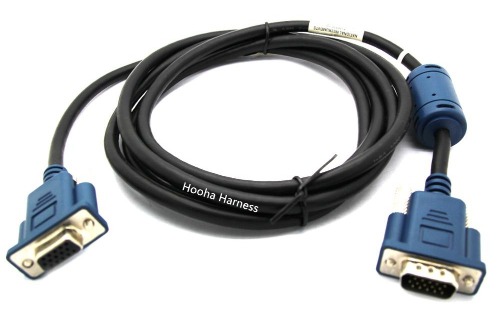
VGA Cable Features
1. 15-Pin Connector
- VGA cables have a 15-pin connector on each end, arranged in three rows of five pins.
- These pins are responsible for transmitting the analog video signal.
2. Analog Signal Transmission
- VGA cables carry analog signals, which can lead to signal degradation over long distances, as opposed to digital signals (like HDMI or DisplayPort).
- The resolution and signal strength may degrade after a certain distance (typically beyond 5 meters).
3. Resolution Support
- Supports a variety of video resolutions, generally up to 1080p (Full HD) but capable of handling up to 2048 x 1536 pixels depending on the quality of the cable.
- Lower resolution at higher distances due to signal loss.
4. Ferrite Cores
- Many VGA cables include ferrite cores (cylindrical bulges near the ends of the cable) to reduce electromagnetic interference and improve signal quality.
5. Shielding
- Most VGA cables are shielded to reduce interference from external sources, such as other cables or electronic devices, which could cause noise in the video signal.
6. Durability
- Often reinforced with a thick rubber or PVC jacket for protection.
- Higher-quality cables may also have gold-plated connectors to enhance durability and reduce signal loss.
7. Compatibility
- Widely compatible with various devices that have VGA ports, including older computers, projectors, monitors, and some TVs.
8. Cable Length
- VGA cables come in a variety of lengths, ranging from 1 meter to 15 meters, although longer cables can result in a loss of signal quality without the use of signal boosters.
9. Gender of Connectors
- Typically, the cables have male-to-male connectors, but adapters can be used for male-to-female connections if necessary.
10. Color Code
- VGA connectors are often colored blue for easy identification, although black and other colors are also common.
VGA to VGA Cable Wiring Diagram
A standard VGA connector has 15 pins arranged in three rows of five.
| VGA A side | VGA B side | Functions |
| Pin 1 | Pin 1 | Red Video |
| Pin 2 | Pin 2 | Green Video |
| Pin 3 | Pin 3 | Blue Video |
| Pin 4 | Pin 4 | Ground |
| Pin 5 | Pin 5 | Ground |
| Pin 6 | Pin 6 | Red Ground |
| Pin 7 | Pin 7 | Green Ground |
| Pin 8 | Pin 8 | Blue Ground |
| Pin 9 | Pin 9 | Not Used (or +5V in some cases) |
| Pin 10 | Pin 10 | Sync Ground |
| Pin 11 | Pin 11 | ID0 / Monitor ID Bit |
| Pin 12 | Pin 12 | ID1 / DDC Data |
| Pin 13 | Pin 13 | Horizontal Sync |
| Pin 14 | Pin 14 | Vertical Sync |
| Pin 15 | Pin 15 | ID3 / DDC Clock |
Notes:
- Video Signal (RGB): Pins 1, 2, and 3 are for the Red, Green, and Blue video signals, respectively.
- Sync Signals: Pins 13 and 14 are for Horizontal and Vertical Sync signals.
- Grounding: Various ground pins are provided to ensure proper grounding of each signal.
VGA to VGA Cable Applications
1. Computer to Monitor
- Application: Used to connect desktop or laptop computers to external monitors.
- Purpose: Transmits analog video signals for displaying the computer’s output on a larger screen.
2. Projector Connection
- Application: Connects a computer, laptop, or media player to a projector.
- Purpose: Allows for projection of video or presentations in classrooms, meeting rooms, or home theaters.
3. KVM Switches
- Application: Used in conjunction with KVM (Keyboard, Video, Mouse) switches.
- Purpose: Allows users to control multiple computers using a single keyboard, monitor, and mouse.
4. Older Gaming Consoles
- Application: Connects older gaming consoles or devices with VGA output to a display or TV.
- Purpose: Provides video output for retro gaming setups.
5. Security Systems
- Application: Connects VGA-compatible DVRs (Digital Video Recorders) or security cameras to a display.
- Purpose: Allows for the monitoring of security footage on a larger screen.
6. Legacy Devices
- Application: Connects older video playback devices such as DVD players or VCRs that support VGA output to monitors or televisions.
- Purpose: Enables the playback of media from older sources.
Related VGA Cable Adapters

DB 9P to IDC 10P flat ribbon cable
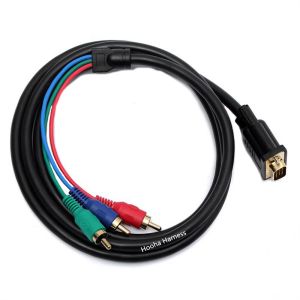
RCA Cable to VGA
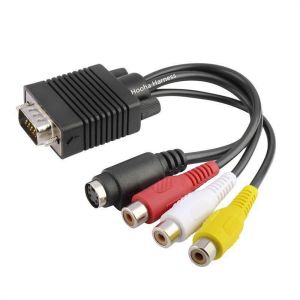
RCA to VGA Cable
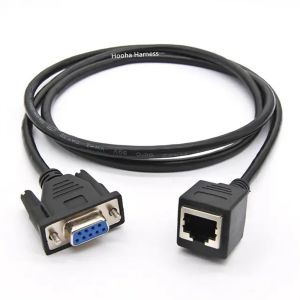
RJ45 to VGA Cable
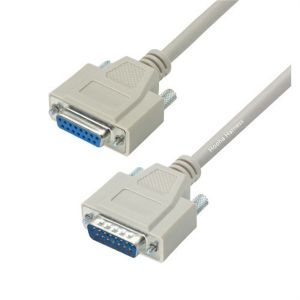
VGA Cable Male to Female
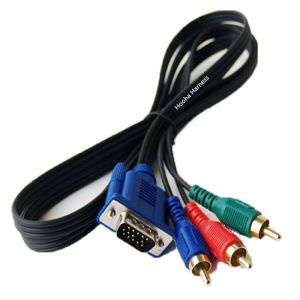
VGA Cable to RCA
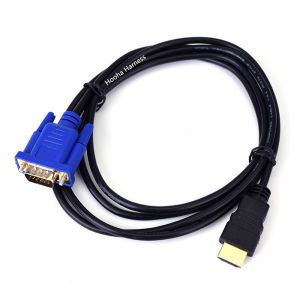
VGA to HDMI Cable
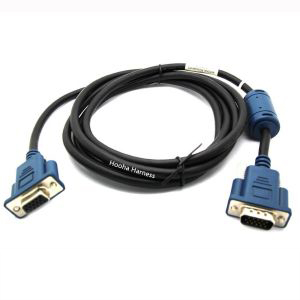
vga to vga cable
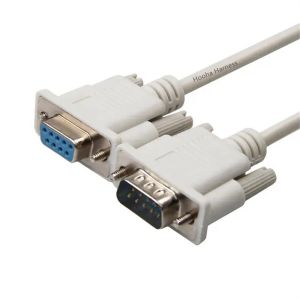
VGA to VGA Monitor Cable
How to customize your cable harness?
Send us your sample or drawing/schematic for quote price→ Feedback with quotation(1~3 days) → Confirm quotation → Arrange sample you for approval→ [Make mold if needed (7 days) →Mold test] → Making samples(1~3 days)→Samples test(Approval) → place order for Mass production(2~3 weeks)→ Quality checking→ Packing → Delivery → After Service → Repeat Order.
